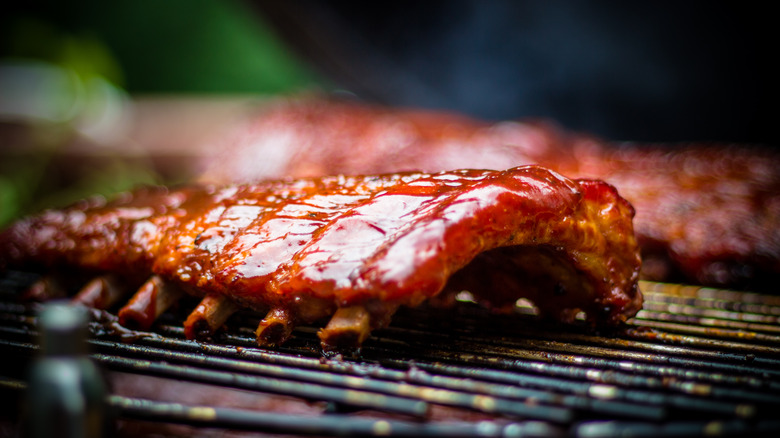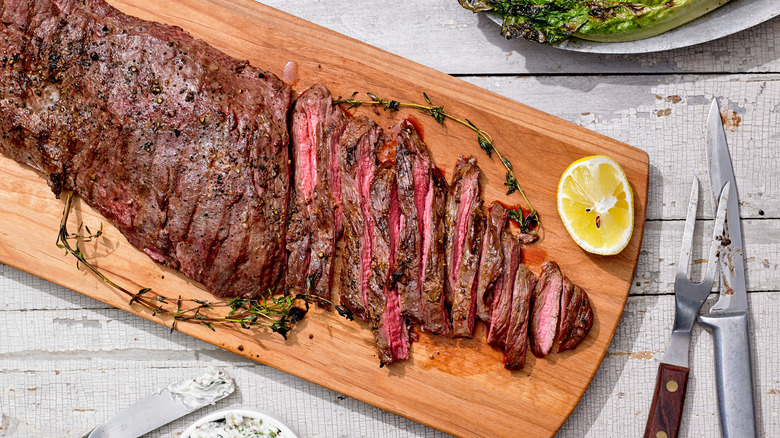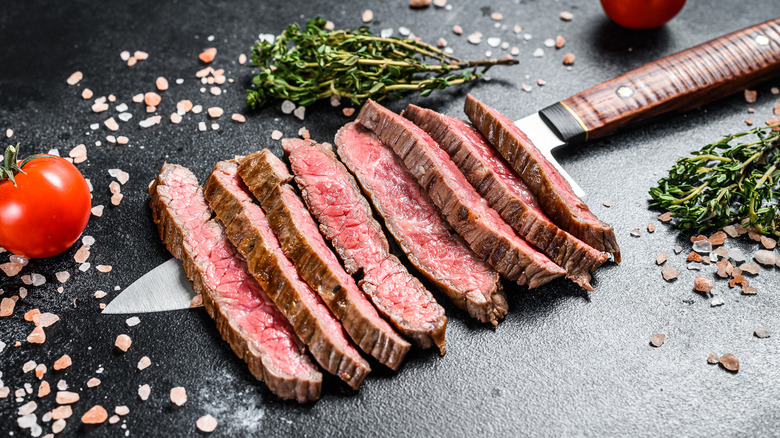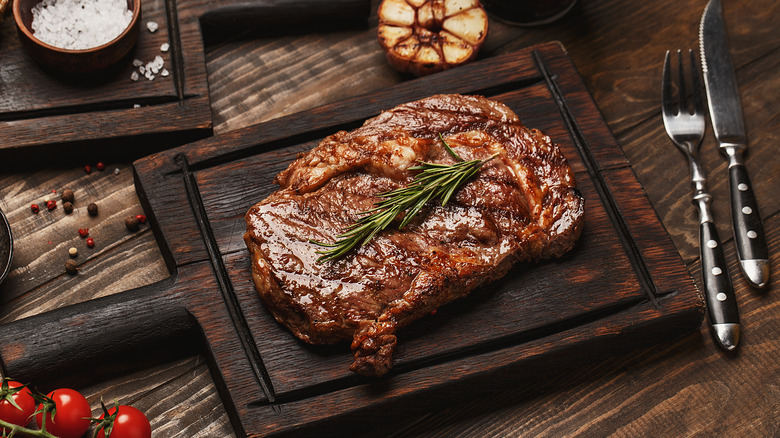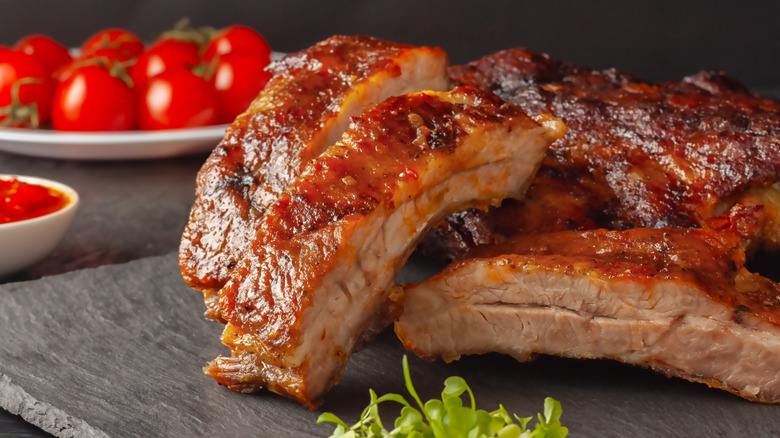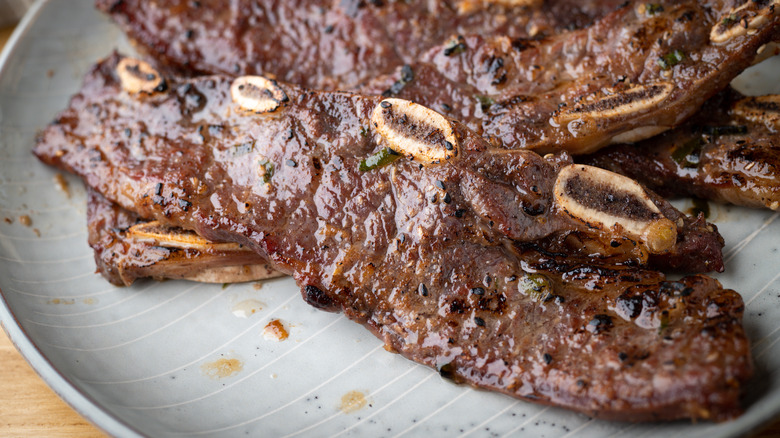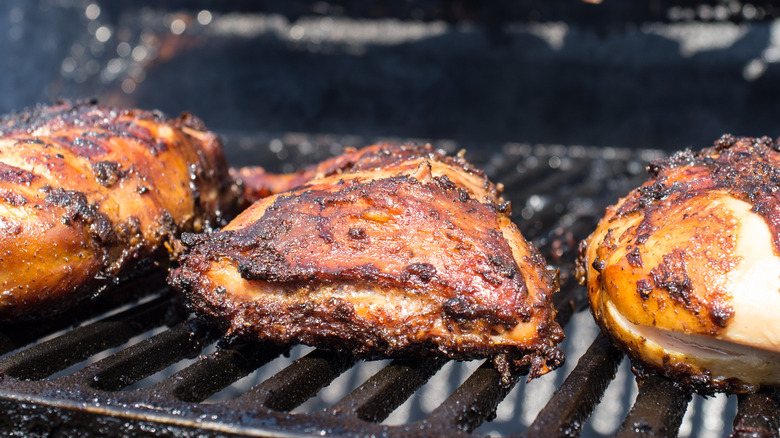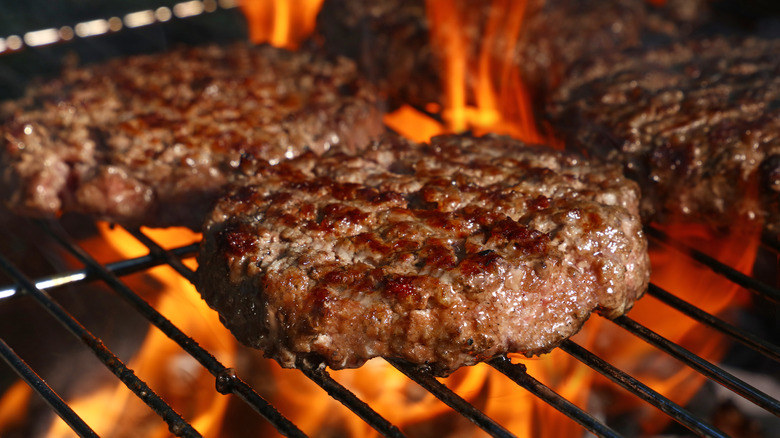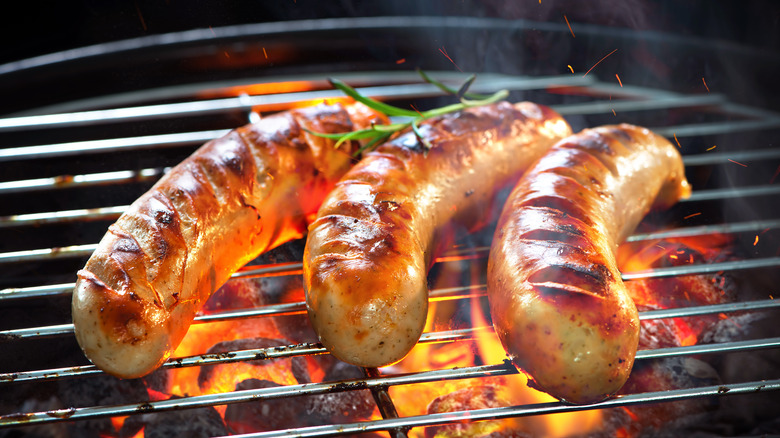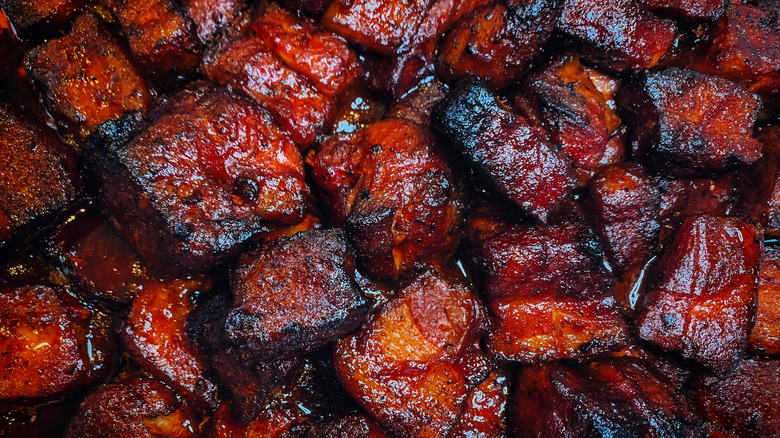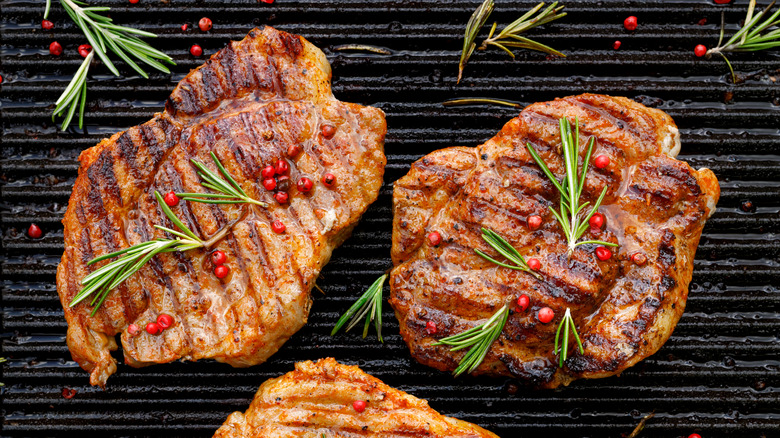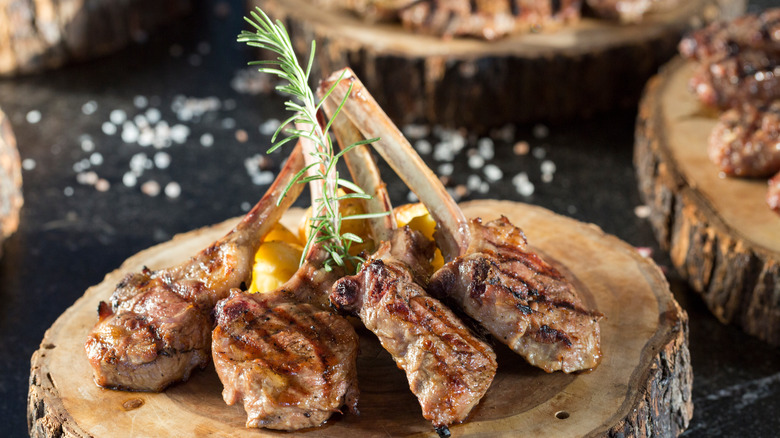The Absolute Best Cuts Of Meat For Grilling
Your grill is capable of far more than just hamburgers and hot dogs. The summer months are the time for your grill to shine. The smell of the smoke and the taste of the grill marks are iconic sensory pleasures that should be pushed to their full potential. Your local butcher shop is sure to be stocked with cuts of meat (the variety of steak cuts available is astounding) fit for serving everything from large gatherings to a simple summer date night between you and your better half.
Not only does the food coming off your grill taste better because you're sharing the experience with the ones you love in the sunshine, but finding new things to throw on the grill will make the whole experience more exciting. But no matter what you place on your grill this summer, it is sure to be mouthwatering. Here are the best cuts of meat to grill that can nourish, impress, or introduce new flavors to anyone you welcome to your home.
Skirt steak
Skirt steak comes from the abdomen of the cow, specifically the diaphragm, which makes it a more hyperactive muscle, and therefore a tougher cut. Skirt steak is held together by thick muscle fibers, so cooking it on high heat for a short amount of time makes it an ideal option for the grill. Plus, cuts of skirt steak are available in a variety of sizes, so no matter who you are cooking for, there will be enough to go around. Furthermore, the toughness of skirt steak means that it takes a long time to marinade, so preparation should be done the day before cooking so that flavor and tenderness are optimized.
Skirt steak usually has a higher fat content, which helps balance out the stronger muscle fibers and the fat contributes to the more meaty flavor. Because of the thick muscle fibers, however, skirt steak must be sliced across the grain, or else you'll be left with stringy beef. The Kansas City Steak Company notes that skirt steak only needs between five and seven minutes on the grill. With the prep already done and the short cooking time, you can be done grilling and enjoying some delicious, tender beef with your friends and family in no time.
Flat iron steak
Flat iron steak is similar in shape and size to skirt steak, but this cut comes from an entirely different part of the cow. Flat iron steaks are cuts from the shoulder, or chuck, which is a more relaxed area of the cow that makes for a higher and more evenly distributed amount of fat. Unlike skirt steak, flat iron steak can be cooked without the sacrifice of your desired texture or flavor.
According to Grilling Companion, your only job with flat iron steak is to keep it simple. The high-fat content and uniform thickness make for quick, attentive grilling that doesn't require much else. Like skirt steaks, flat iron steaks are uniform in thickness, making this cut an elevated vehicle for marinades and a scorching hot sear on the grill. Flat iron steaks are perfect for slicing up thin, plating, and passing around for everyone to plate their desired portion. The many enhanced qualities found in flat iron steak are reflected in its price, however. While flat iron steak is nowhere close in price to some other cuts of beef, feeding the whole family with flat irons will certainly cost more than skirt steaks will. However, the versatility, simplicity, and deliciousness of this cut certainly make the extra cost worth it.
Ribeye steak
The ribeye is undoubtedly the king of all steaks. According to Steak University, ribeyes are cut directly from the ribcage of the cow and are surrounded by and marbled with copious amounts of fat, making its flavor unparalleled by any other cut of beef. As the fat melts down, the fibers of the meat open up and are allowed to absorb more flavor — the ribeye is the pinnacle of that reaction. Especially on a grill, the tenderness of a ribeye is achieved by a quick, super hot sear accompanied by that iconic smokiness.
Ribeyes will, however, be a more costly option than other items on this list. While the ribeye is certainly the best bang for your buck in terms of quality versus comparable cost, purchasing one ribeye per person may not be the most cost-efficient option. Furthermore, for a date night with your significant other or when celebrating some alone time, tossing a simply seasoned, ribeye steak on a hot grill may be the best way to spend an evening (without spending your paycheck).
When cooking a ribeye steak, you should pay close attention to what you're doing. All steaks are their most flavorful and tender with a medium-rare interior, and charts calculating cooking times should not be adhered to blindly, according to 101 Cooking For Two. Instead, a meat thermometer is the best way to ensure you get the most out of your ribeye, and it will put your mind at ease in the process.
Ribs
Of all the meats on this list, ribs may be the most far-reaching crowd pleaser. When done right, ribs are juicy, smoky, sweet, savory, and delightfully messy. However, making delicious ribs at home can be intimidating. Most restaurants that serve ribs do so on expensive smokers with specific types of wood that are not always accessible to the common home cook. Also, the prep of ribs can be misunderstood as time-consuming, but the only trimming needed is the removal of the ribs' silver skin, which can be peeled off all in one piece, according to The Country Cook.
The best way to cook ribs on the grill is to cover them inside an aluminum pan. Because the ribs will need to cook for up to two hours, placing them directly on the grill grates will cause the outside to overcook before the inside is cooked at all. Therefore, if your grill has three burners on it, it is best to leave the middle one off and only use the ends. The indirect heat source will allow your ribs to cook evenly without sacrificing any of the tenderness or juiciness desired. Once the internal temperature is almost where you want it to be, removing the ribs from the pan and placing them directly on the grill will help achieve those delicious and aromatic grill marks.
Ribs are inexpensive, relatively low maintenance, and delicious when cooked properly. Out of all the cookout foods, there are few more comforting than pork ribs.
Flanken short ribs
Short ribs are a luxurious, hearty meal fit for the whole family. Usually braised for hours on end with a classic mirepoix (and maybe a red wine reduction), they are fork-tender, savory, and delicious. Flanken short ribs, on the other hand, are an alternative to this wonderfully fatty and tender cut, and they can be cooked and ready to eat in minutes. Flanken short ribs, also referred to as "LA-style short ribs," are a popular cut in Korean cuisine as a dish called galbi, which means ribs, according to Maangchi. These are short ribs that are cut across the bone as opposed to alongside it, and the result is super thin, perfectly portioned cuts practically designed for the grill, according to Oh Snap! Let's Eat.
The best part about flanken short ribs is how simple they are to prepare and how quickly they cook. Marinating can be done as far as 24 hours ahead of cooking and, once the grill is fired up, these pieces of meat will cook and accumulate a beautiful char in less than five minutes. The marinade itself is up to your preference, of course, but traditional Korean galbi is prepared with a soy sauce-based marinade with ginger and garlic. Flanken short ribs are the perfect meat to add to your summertime barbecue — if you're not already.
Chicken thighs/drumsticks
Although dark meat is not everyone's preference, it does cater better to the grill. White meat cooks much faster than dark meat, and while this may seem like an advantage, the temperature of backyard grills can be difficult to control and white meat often comes off the grill dry and overcooked.
Grilling chicken thighs or drumsticks on the grill is not as simple as tossing them on and pulling them off once the outside is crispy. The internal temperature of chicken is imperative and is only considered edible once it reaches 160 degrees Fahrenheit, according to A Family Feast. High heat on the chicken will cause the outside to be done before the inside has a chance to cook. Then, the chicken you've been excited to dig into will be ruined. Luckily, there are a variety of ways to achieve a nicely charred and crispy exterior and a tender, juicy interior.
For example, you can pre-cook your chicken before it hits the grill to ensure the right internal doneness, according to Live Strong. Then, all that remains is charring the outside. This can be done by boiling the chicken ahead of time, microwaving it, or baking the chicken in the oven for an extended amount of time at a lower temperature. Or, you can sear your chicken first and then leave it to finish cooking at a steady temperature.
Ground beef (burgers)
Burgers are the undisputed champion of the summer cookout. Cooking burgers, however, is not the same as cooking a whole steak. According to Fine Cooking, meat is a combination of protein and fat that forms a muscle. When beef is ground up, the muscle fibers are pulverized, which causes moisture to leak out more easily. Therefore, how you cook your burger is very important to make sure the moisture remains inside.
Once it's time to cook your burgers, handle them as little as possible. Every time you relocate or flip your burgers, more moisture escapes. This is why a raging hot grill is important for cooking burgers. However, too hot of a grill will turn your beautifully caramelized exteriors into burnt ones. Therefore, you should heat your grill into zones of varying temperatures. Once a deep brown crust is achieved, moving your burgers to low heat will ensure the inside is cooked to your liking and the crusty exterior is not compromised.
Pork sausage
Sausages are the one full-proof way to encapsulate every great aspect of pork into one item. Sausage seasonings are evenly distributed, always juicy, and provide that impeccable snap with every bite. All of these characteristics make sausage fantastic no matter the type you decide on. Plus, sausages are inexpensive, so not only can you afford to feed the whole family, but the wide variety of sausages available will ensure nobody ever gets bored of them. As straightforward as sausages are, however, there are some key things to avoid as well as some extra lengths you can take to enhance this humble meat.
For example, the temperature must never remain a constant, according to Serious Eats. High heat throughout will cause the sausage casing to burst and the inside to not quite reach doneness. Low heat all the way through may appear to work, but you'll soon find your sausages go from plump to deflated and wrinkled.
The only true way to accomplish an evenly juicy inside and a sharp, deep brown outside is to simmer the sausages in an aluminum pan on the grill and then sear them with grill marks afterward. The pan can be filled with anything you like such as herbs, mustard, beer, and more. This is essentially the same concept as a reverse sear — beginning with lower temperatures to ensure an even cook and then transferring to a hot grill for a final stamp of flavor.
Pork belly
Pork belly is a cut of meat we would savor every morning if we could. This cut of meat has an equal 50% fat and 50% muscle, according to Vindulge. Before it becomes bacon, pork belly is a delicious cut of pork that can rival any other. Cut in between the skin and the spare ribs, this 50/50 ratio makes for an abundance of flavor that can be brought out through a variety of methods.
Pork belly can be purchased sliced into individual strips, cubed to make classic barbecue burnt ends, or left as a whole cut. Although the best pork belly is made using a smoker, it can also be cooked without one. Seasonings, rubs, and sauces are important, yes, but the high-fat content that makes pork belly delicious is what should shine. The whole pork belly can be reverse seared. Just apply any seasonings or tubs, put them in an aluminum pan, cover, and place on the grill. Like ribs, the longer the better. The slower the pork belly cooks, the more evenly it will cook. Plus, it will have a longer amount of time to absorb the flavors you applied. Once the pork belly reaches your desired internal temperature, a final sear on direct, high heat will finish it off with smoke and char. You don't need expensive equipment to make delicious pork belly, it just takes some patience.
Pork chops
Pork chops are a polarizing cut of meat. Too often, pork chops are not cooked properly and they end up far overcooked and bone dry. Pork is intense in flavor, and that flavor should be preserved and amplified as much as possible.
The best way to ensure your pork chops are not like the ones that have turned people off is to use a meat thermometer. By pulling your pork chops off the grill with an internal temperature of 140 degrees Fahrenheit, a short resting period will allow that temperature to rise to a perfect 145 degrees Fahrenheit. Pork chops take a long time to marinate, which also helps to preserve moisture. While all grills may be a little different, it is recommended that pork chops need about eight minutes on each side. Because pork chops are usually only 1-inch thick, only medium heat is needed on the grill. One side of the grill should be completely off to be used as a cool zone. If the outside of the pork chops look as if they may be getting ahead of the inside, a quick relocation to the cooling zone will even everything out.
Grilling pork chops may seem like it requires a little more attention to detail, but that extra effort will result in delightfully juicy, delicious pork that is sure to encourage those who had a bad experience with them to rethink their position.
Lamb chops
Lamb is a meat that too often goes overlooked, probably because of the price. However, treating yourself to a grilled lamb is a decadent treat for special occasions. Grilling lamb for loved ones will definitely be at least one person's introduction to it, so be prepared to make that introduction positive.
A lot of people who have had lamb before may not like it because they claim it is too gamey. According to BBQ Champs Academy, make sure it doesn't taste gamey by buying a quality cut. Lamb should be bright pink with smooth white fat and red streaks running through the bone. Cuts that are darker and almost purple with more off-colored fat come from an older lamb. This is the "gamey" lamb that turns people off. The older the meat is, the less lean and tender it will be. And there are surprisingly many cuts of lamb available, so research what you want before heading to the butcher.
Fresh herbs and citrus are easy ways to brighten up your lamb and complement its flavor. The internal temperature of lamb should not exceed 150 degrees Fahrenheit, which is medium. Anything higher and the lamb will turn into that tough, gamey meat despite its quality. The best method is to pull the lamb chops off the grill at 135 degrees Fahrenheit and let them rest until they reach 140 degrees Fahrenheit. With a two-zoned grill, your well-seasoned, grill-marked lamb will be evenly cooked, tender, decadent, and memorable.
